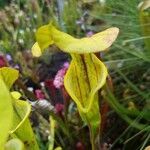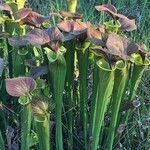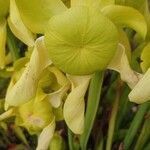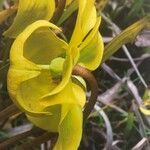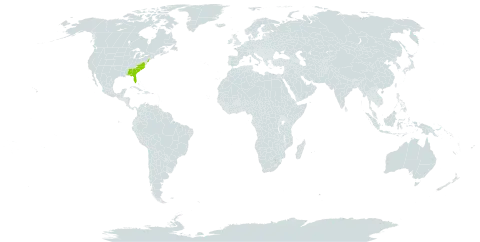Plants forming dense clumps; rhizomes 1-2.5 cm diam. Pitchers marcescent, appearing after the first flowers, producing 1 flush of pitchers in spring through early summer, erect, yellowish green throughout, often with dark red blotches on neck, dark red veins on distal portions of tube and hood, or whole tube heavily suffused bronze or purplish red, without white areolae, 25-90(-100) cm, thick, firm, surfaces glabrous, wings 0.5-1(-2) cm wide; orifice broadly ovate, 2-7(-8) cm diam., rim green, flaring and loosely revolute, often with prominent, everted indentation immediately distal to wing forming spout over wing; hood recurved adaxially, held well beyond and covering orifice, yellow-green, red-veined or suffused with bronze-red, without white areolae, orbiculate-reniform, not undulate, 3-10 × (3-)5-14 cm, ± as long as wide, proximal margins broadly cordate, opposite lobes reflexed abaxially, touching or nearly touching, neck (often red-blotched or red-veined), constricted, 1-3 cm, margins revolute, apiculum (2-)3-12(-18) mm, adaxial surface glabrous. Phyllodia 2-4(-5), erect, oblanciform, (8-)12-30 × 1-3 cm. Scapes 15-60 cm, shorter than pitchers; bracts 1-2 cm. Flowers strongly ill-scented; sepals yellowish green, 3-5 × 2-3.5 cm; petals yellow, distal portion ovate to narrowly elliptic, 5-8.5 × 3-4 cm, margins entire; style disc yellow-green, 6-8 cm diam. Capsules 1.4-2 cm diam. Seeds 1.8-2.5 mm. 2n = 26.
More
Lvs erect, 3–8 dm, slender, gradually widened distally and widest at the summit, the wing seldom as much as 1 cm wide, the hood depressed-ovate and raised on a stipe-like base; scapes to 1 m; fls 8–10 cm wide, the pet yellow; 2n=26. Sandy bogs and wet pine-lands; se. Va. to n. Fla. and s. Ala. May. A hybrid with no. 1 [Sarracenia purpurea L.] is S. ×catesbaei Elliott.
Can be grown by cuttings, divisions or seedlings. Seeds needs stratification.

